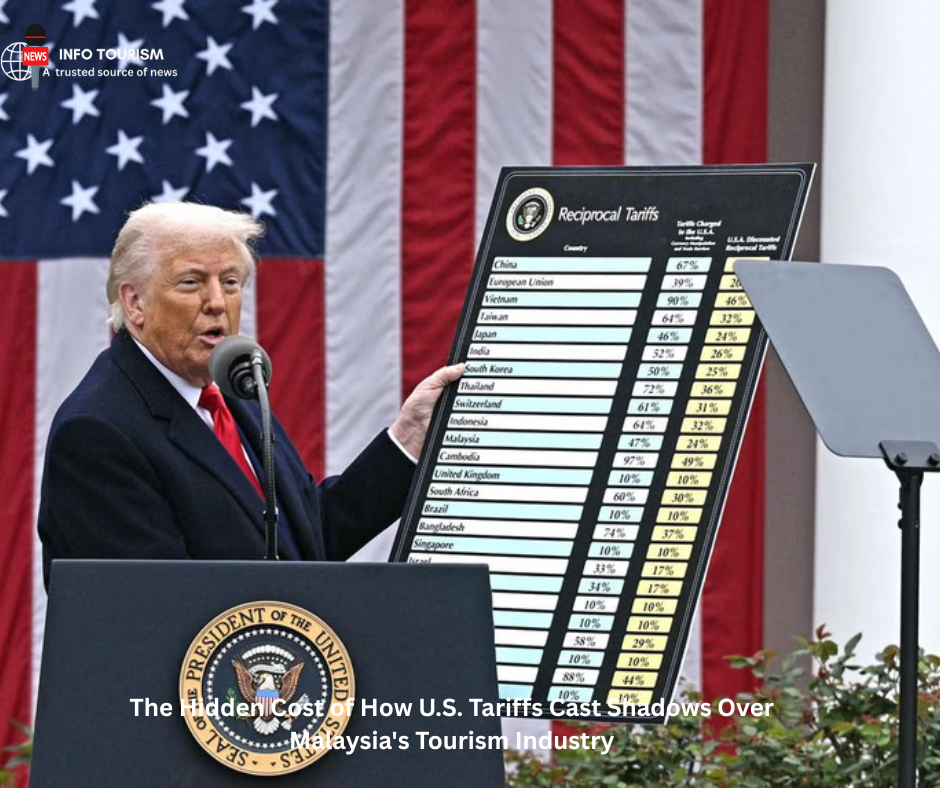April 2025, Johor Bahru — When reports broke that the United States had imposed a 24% tariff on Malaysian imports with effect from April 9, the limelight predictably fell on manufacturing, palm oil, and electrical components. But under the radar, another sector stands quietly at risk: tourism.
While not in the tariff bullseye, Malaysia’s tourism industry is already bracing for what could be a wave of indirect effects—ripples that threaten short-term growth and long-term confidence in one of the nation’s most significant economic lifelines.
Tourism: The Unsuspecting Collateral
Malaysia earned RM102.7 billion worth of tourist receipts in 2023, and will likely achieve RM125.5 billion in 2025. This increase is vulnerable to the economic uncertainty caused by the trade war. Tariffs may not be imposed on nasi lemak, hotel beds, or flights—but they erode the purchasing power, business environment, and global reputation that support them.
“Tourism does not occur in a vacuum,” says Universiti Kebangsaan Malaysia’s Centre for Economic Diplomacy Professor Nik Hanim. “When business is tight, people get laid off and prices increase, then travelling is a luxury—not an option. It hurts domestic and inbound tourism.”
Reducing Middle-Class Recreational Spending
One of the first likely impacts is the erosion of Malaysia’s middle-class domestic holidaymakers. When export-oriented businesses pass on costs to customers or cut staff, families may reconsider leisure expenditure. Weekend getaways, theme parks, and cultural events—staples of Malaysia’s internal tourism—may see reduced turnout.
This is particularly cause for concern as 70% of Malaysia’s domestic tourists are responsible for creating tourism expenditure, according to Tourism Malaysia’s recent report. The middle class scaling back its consumption will hit secondary cities’ hotel, homestay, restaurant, and transportation services the worst.
International Confidence and Image at Stake
Tourism is not a service; it is perception. A country that is viewed to be bogged down in economic uncertainty or geopolitical tensions risks missing out on being overlooked by foreign visitors and investors.
American tariffs send a message—whether unintentional or not—that Malaysia is on the wrong side of a global economic superpower. Visitors do not understand trade policy nuances, but “policy uncertainty” and “economic retaliation” front-page headlines have a way of affecting travel decisions. It’s a reputational threat few in tourism are talking about openly.
Additionally, with the Visit Malaysia 2026 campaign headed for having over 35 million visitors, it is also a prime priority time to portray Malaysia as being stable, inviting, and commerce-friendly.
Investor Wariness and Project On-Time
Behind the scenes, long-term investor confidence and foreign direct investment (FDI) rely on mass tourist infrastructure—cruise facilities, nature resorts, and theme parks. Trade wars generate uncertainty. Investors may delay or withdraw planned project funding if they believe Malaysia is susceptible to prolonged tariff wars.
Such reluctance has a multiplier impact: when mega-projects fail, employment generation is deferred, and local tourist hubs cannot create the connectivity and concentration of sites to compete locally.
What Can Be Done?
Policymakers must act fast. Three swift measures can buffer the tourism industry from collateral damage:
Assure international partners through targeted diplomacy and media communications that Malaysia remains an open and stable destination.
Stimulate domestic tourism through tax subsidies or refunds to encourage consumption in the M40 and B40 income groups.
Accelerate regional partnerships to reduce dependence on long-haul markets like the U.S. and EU, and increase travel flows from ASEAN, the Middle East, and South Asia.
Conclusion: Reading Between the Tariff Lines
Malaysia’s tourism economy may not appear in tariff books, but it’s surely on the economic front lines. When trade wars ratchet up, we must widen our scope of who suffers and how. Tourism, so blithely splashed into the rainbow of beaches and skylines, is pretty deeply economic—and fantastically vulnerable.
Over the next few months, the work is not merely to greet tourists, but to safeguard the system through which they can arrive. The ripple effect is not imaginary. And if we delay until now, Malaysia will have to pay dearly outside the ports.

